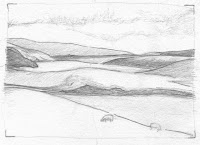I didn't want the amount of mat to overwhelm these small paintings, so I used 1.5" wide mats. I spent some time testing different colored mats with the paintings. The often repeated recommendation is to use neutral off white colors. I found different colors worked with different paintings. Some looked best with tan or pale shades of green, others looked best with darker blues and greens. When the right mat was used the the painting seemed to jump to life. I tried single mats and double mats, and found that I consistently preferred double mats.
Matted and sitting side by side it was easy to pick out 4, but eliminating one more from the group was a lot harder. I ended up with two landscapes and one floral. Now I needed to work on the framing.
I wanted the frames to complement the painting and fit their style. After looking at a lot of frames I selected simple dark wood frames for the landscapes and gold frames with a bit of a decoration for the florals. Now all the pieces needed to be put together.
The glass was cleaned and dried. The paintings were attached to the back of the mats using two pieces of acid free water soluble gummed tape along the top of the paper. The matted paintings were placed on top of the glass. Acid free tissue paper barrier was placed between the paintings and the backing board. The whole stack was secured in the frame. A brown paper dust cover was added to the back of the wood frame. The final step was to add eye hooks and attach twisted wire to them to hang the paintings.
Then off to deliver the paintings I went. None of them were chosen for the exhibit, but these were the first watercolors I had framed so it was a good learning experience for me.

















































